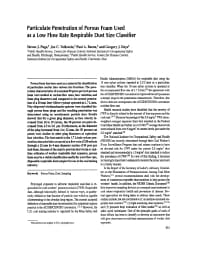Mining Publication: Particulate Penetration of Porous Foam Used as a Low Flow Rate Respirable Dust Size Classifier
Original creation date: July 2000
Authors: SJ Page, JC Volkwein, PA Baron, GJ Deye
NIOSHTIC2 Number: 20020770
Appl Occup Env Hyg 2000 Jul; 15(7):561-568
Porous foam has been used as a material for classification of particulate matter into various size fractions. The penetration characteristics of a nominal 90 pores per inch porous foam were studied at various flow rates, face velocities, and foam plug diameters and compared to the aerosol penetration of a 10 mm Dorr Oliver cyclone operated at 1.7 L/min. Poly-dispersed triethanolamine spheres were classified through porous foam plugs and the resulting penetration was determined using an aerodynamic particle sizer. Results showed that for a given plug diameter, as face velocity increased from 26 to 39 cm/sec, the 50 percent cut point decreased from 4.5 to 3.8 microns. Furthermore, as the diameter of the plug increased from 4 to 12 mm, the 50 percent cut points were similar to other plug diameters at equivalent face velocities. The best match to the 1.7 L/min cyclone penetration characteristics occurred at a flow rate of 250 ml/min through a 25 mm by 4 mm diameter section of 90 pore per inch foam. Because of the need to provide short-term or real-time estimates of worker respirable dust exposure, porous foam may be a viable classification media for a low flow rate, disposable respirable dust sampler for use in the coal mining industry.

NIOSHTIC2 Number: 20020770
Appl Occup Env Hyg 2000 Jul; 15(7):561-568
- Bag and Belt Cleaner Reduces Employee Dust Exposure
- Characterizing Exposures to Airborne Metals and Nanoparticle Emissions in a Refinery
- Continuous Respirable Mine Dust Monitor Development
- Equivalency of a Personal Dust Monitor to the Current United States Coal Mine Respirable Dust Sampler
- Evaluation of the Approach to Respirable Quartz Exposure Control in U.S. Coal Mines
- An Overview of Fundamental and Emerging Technologies to Monitor and Control Respirable Dust in Underground Coal Mines in the United States
- Possible Impact of New Safety Technology Developments on the Future of the United States Mining Industry
- Report on Early Strength Performance of Modern Day Weak Rock Mass Shotcrete Mixes
- Respirable Quartz Hazard Associated with Coal Mine Roof Bolter Dust
- Using Ventilation Control Technology to Reduce Respirable Dust Exposures at U.S. Metal/Nonmetal Mining Operations